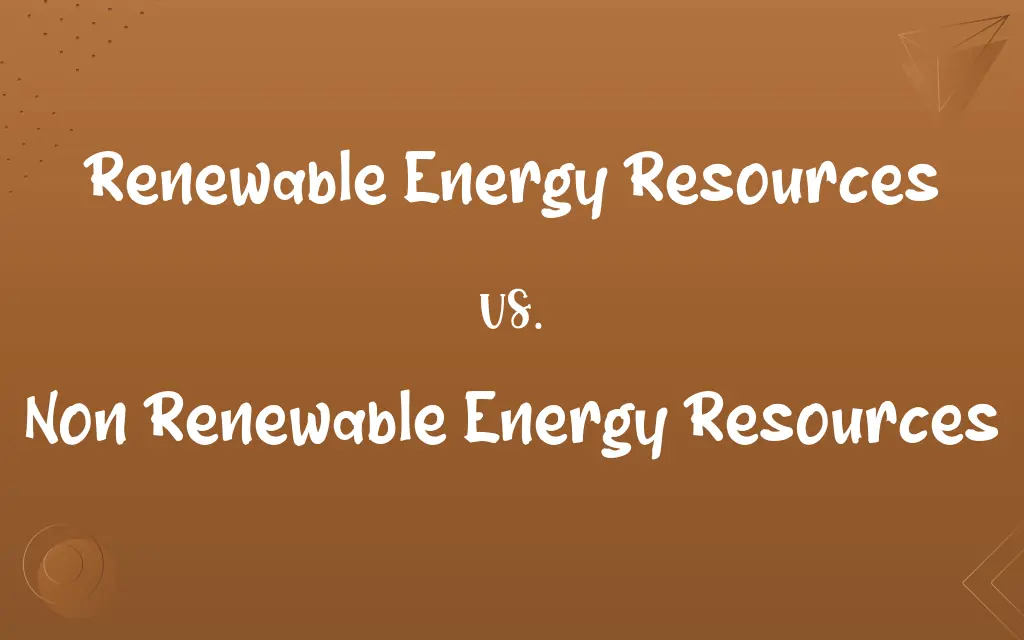Renewable Energy Resources vs. Non Renewable Energy Resources: Know the Difference

By Dua Fatima & Hifza Nasir || Published on July 12, 2024
Renewable energy resources, like solar and wind, naturally replenish and have minimal environmental impact, whereas non-renewable resources, such as coal and oil, are finite and contribute significantly to pollution.

Key Differences
Renewable energy resources, including solar, wind, hydro, and biomass, are derived from sources that regenerate quickly on a human timescale and are virtually inexhaustible. These resources are considered environmentally friendly because their extraction and use produce minimal greenhouse gas emissions, contributing less to climate change. In contrast, non-renewable energy resources, such as coal, oil, natural gas, and nuclear power, originate from sources that take millions of years to form and are depleted much faster than they are replenished. Their extraction and consumption release significant amounts of pollutants and greenhouse gases, posing challenges for environmental sustainability and public health.
Dua Fatima
Jul 12, 2024
The cost and technology associated with harnessing energy from these sources have also seen significant divergence. Renewable energy technologies, such as solar panels and wind turbines, have become more cost-effective and efficient due to advancements and increased investment. Meanwhile, non-renewable energy technologies, while currently more established and capable of providing consistent energy supply, face increasing costs related to extraction difficulties and the need for environmental remediation.
Hifza Nasir
Jul 12, 2024
Energy security and independence are further influenced by these resource types. Renewable energy resources, being distributed and abundant in nature, offer countries the opportunity to reduce dependence on imported fuels, enhancing energy security and stability. Non-renewable resources, however, are often concentrated in specific regions, leading to geopolitical tensions and supply vulnerabilities.
Hifza Nasir
Jul 12, 2024
The transition towards renewable energy is driven by the need to address climate change, reduce environmental degradation, and promote sustainable development. While non-renewable resources have historically dominated energy supply, the shift towards renewables reflects growing awareness of the environmental, economic, and social benefits of sustainable energy sources.
Dua Fatima
Jul 12, 2024
Comparison Chart
Source
Naturally replenishing (solar, wind, hydro)
Finite (coal, oil, natural gas)
Hifza Nasir
Jul 12, 2024
ADVERTISEMENT
Environmental Impact
Lower emissions, minimal impact
High emissions, significant environmental degradation
Dua Fatima
Jul 12, 2024
Cost and Technology
Decreasing cost, improving technology
Increasing extraction costs, mature technology
Hifza Nasir
Jul 12, 2024
Energy Security
Enhances independence and security
Can lead to dependence and geopolitical tensions
Dua Fatima
Jul 12, 2024
Sustainability
Sustainable and supports climate goals
Unsustainable, contributes to climate change
Dua Fatima
Jul 12, 2024
Renewable Energy Resources and Non Renewable Energy Resources Definitions
Renewable Energy Resources
Biomass energy is derived from organic materials.
Wood chips are burned in power plants to create bioenergy.
Shumaila Saeed
Feb 29, 2024
ADVERTISEMENT
Non Renewable Energy Resources
Uranium, used in nuclear energy, is a finite resource.
Uranium mining provides the fuel for nuclear power plants.
Hifza Nasir
Feb 29, 2024
Renewable Energy Resources
Hydroelectric power generates electricity from flowing water.
Dams on rivers produce significant amounts of renewable energy.
Dua Fatima
Feb 29, 2024
Non Renewable Energy Resources
Coal is a fossil fuel used for electricity generation.
Coal-fired power plants are a major source of power and pollution.
Hifza Nasir
Feb 29, 2024
Renewable Energy Resources
Solar energy harnesses sunlight to generate electricity.
Solar panels on rooftops provide clean energy to homes.
Hifza Nasir
Feb 29, 2024
Non Renewable Energy Resources
Nuclear energy comes from splitting atoms.
Nuclear reactors generate power without CO2 emissions but produce radioactive waste.
Dua Fatima
Feb 29, 2024
ADVERTISEMENT
Renewable Energy Resources
Geothermal energy utilizes heat from the Earth's core.
Geothermal plants in volcanic areas supply renewable heat and power.
Shumaila Saeed
Feb 29, 2024
Non Renewable Energy Resources
Oil is extracted and refined into fuels.
Gasoline, derived from oil, powers most of the world's vehicles.
Dua Fatima
Feb 29, 2024
Renewable Energy Resources
Wind energy converts air flow into electricity.
Wind turbines in wind farms supply power to the grid.
Dua Fatima
Feb 29, 2024
Non Renewable Energy Resources
Natural gas is used for heating and electricity.
Natural gas-fired plants are a flexible source of power generation.
Dua Fatima
Feb 29, 2024
Repeatedly Asked Queries
What are the environmental impacts of non-renewable energy?
They include air and water pollution, greenhouse gas emissions, habitat destruction, and health risks to humans and wildlife.
Dua Fatima
Jul 12, 2024
What are renewable energy resources?
Renewable energy resources are those that can be replenished naturally on a short human timescale, such as solar and wind energy.
Hifza Nasir
Jul 12, 2024
Can renewable energy replace non-renewable energy?
Yes, with technological advancements and increased investment, renewable energy has the potential to significantly replace non-renewable sources.
Dua Fatima
Jul 12, 2024
How do renewable energy resources contribute to energy security?
By reducing dependence on imported fuels and utilizing local resources, enhancing national energy security and stability.
Hifza Nasir
Jul 12, 2024
Why is the cost of non-renewable energy rising?
Due to harder extraction processes, environmental regulations, and diminishing reserves.
Shumaila Saeed
Jul 12, 2024
Why are renewable energy resources considered more sustainable?
They are sustainable because they generate less pollution, reduce greenhouse gas emissions, and are inexhaustible on a human timescale.
Dua Fatima
Jul 12, 2024
What challenges do renewable energy technologies face?
Challenges include storage, intermittency, current infrastructure compatibility, and initial investment costs.
Dua Fatima
Jul 12, 2024
Are all renewable energy sources pollution-free?
While they have a significantly lower environmental impact, some processes associated with renewable energy can have minimal adverse effects.
Hifza Nasir
Jul 12, 2024
How do renewable and non-renewable energy resources affect climate change?
Renewable energy mitigates climate change by reducing emissions, while non-renewable energy exacerbates it through high carbon emissions.
Dua Fatima
Jul 12, 2024
Can energy efficiency reduce the need for non-renewable resources?
Yes, improving energy efficiency reduces overall energy demand, lessening dependence on non-renewable energy sources.
Hifza Nasir
Jul 12, 2024
What are non-renewable energy resources?
Non-renewable energy resources are finite sources of energy like coal and oil that cannot be replenished within a human lifespan.
Hifza Nasir
Jul 12, 2024
What role does technology play in the use of renewable energy?
Technological advancements improve efficiency, reduce costs, and enable the integration of renewable sources into the energy system.
Dua Fatima
Jul 12, 2024
What are the economic benefits of transitioning to renewable energy?
Benefits include job creation in new energy sectors, reduced healthcare costs from pollution, and protection against fossil fuel price volatility.
Dua Fatima
Jul 12, 2024
What is the potential of nuclear energy as a clean energy source?
Nuclear energy offers low-carbon electricity but faces challenges related to radioactive waste disposal and public safety concerns.
Dua Fatima
Jul 12, 2024
How does energy consumption affect geopolitical tensions?
Dependence on non-renewable energy sources from geopolitically sensitive regions can lead to tensions and conflicts over energy access and control.
Dua Fatima
Jul 12, 2024
Share this page
Link for your blog / website
HTML
Link to share via messenger
About Author
Written by
Dua FatimaCo-written by
Hifza Nasir


































































